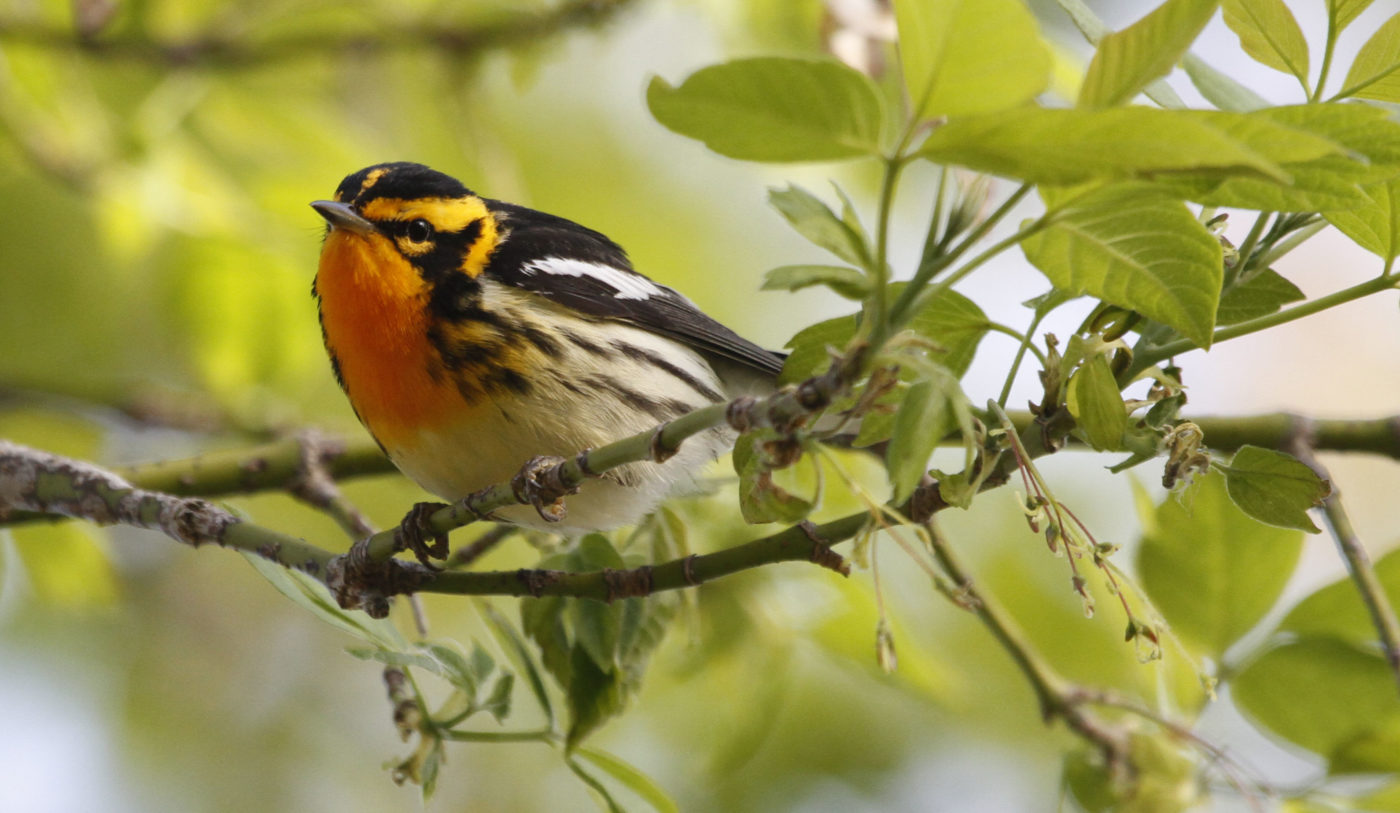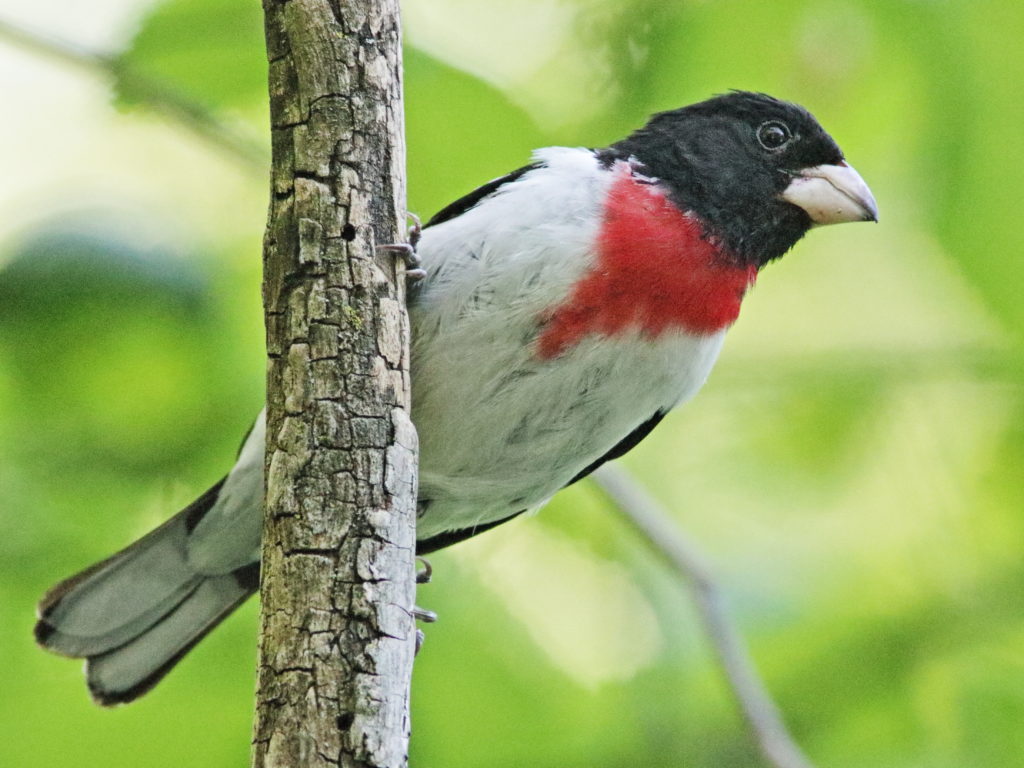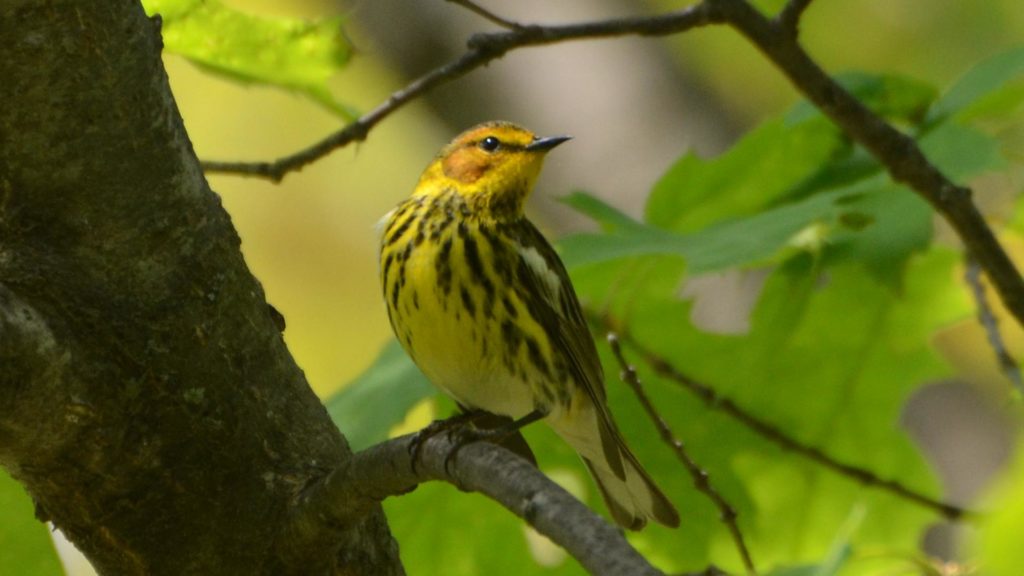
Blackburnian warbler photo by Paul Hurtado.
By Jessica Ruthenberg, Watchable Wildlife Biologist, Virginia Department of Game and Inland Fisheries
Each spring in Virginia, warblers and other neotropical songbirds travel through Virginia along the Atlantic Flyway. These beautiful birds are referred to as neotropical because they are returning to North America for their breeding season after spending their winter in Central and South America. This annual journey presents a marvelous opportunity to experience the colors and sounds of spring migration.
Many of these songbirds migrate at night, and, as they pass through the Commonwealth, they seek patches of forest to stopover. Places like Virginia’s National Wildlife Refuges, State Parks, Wildlife Management Areas, and local nature trails can be ideal places to spot these migrants. These habitats provide protective cover, making a safe place for the birds to rest. They also offer abundant insects, a critically nutritious food source for the birds to replenish their energy before heading off on the next leg of their journey.
Celebrate The Year of the Bird by getting outdoors and viewing spring migration. Read our tips below for finding spring migrants, then get out and go!

Rose-breasted grosbeak photo by Kenneth Cole Schneider.
Where and When to See Warblers
These sites on the Virginia Birding and Wildlife Trail are your best-bet locations for spotting migratory warblers. The best time to go is April – May. Birders have already begun reporting sightings of early migrants!
Hampton Roads
- Great Dismal Swamp National Wildlife Refuge – Don’t miss their Migration Celebration, April 26-28!
- Back Bay National Wildlife Refuge
- First Landing State Park
Eastern Shore
Lower Peninsula
Richmond Area
- James River Park System, 42nd Street Entrance
- Dutch Gap Conservation Area/ Henricus Park
- John J. Radcliffe Appomattox River Conservation Area
Northern Neck
- Westmoreland State Park
- Stratford Hall Plantation
- Rappahannock River Valley National Wildlife Refuge, Wilna Unit
Northern Virginia
- Wakefield Park
- Huntley Meadows
- Prince William Forest Park
- Leesylvania State Park
- Merrimac Farm Wildlife Management Area
- Banshee Reeks Nature Preserve
Appalachian Mountains, Northern Virginia
- Ivy Creek Natural Area
- Spruce Creek Park
- Shenandoah National Park – South River Falls Trail
- Edith J. Carrier Arboretum
- Hone Quarry Recreation Area
- Richard Thompson Wildlife Management Area
- Sky Meadows State Park
Appalachian Mountains, Southwestern Virginia
- Breaks Interstate Park
- Pandapas Pond
- Mountain Lake Resort
- Mill Mountain Park
- Peaks of Otter Recreation Area
- Warbler Road
- Natural Bridge State Park

Cape May warbler photo by Andy Reao and Chrissy McLarren.
How to Spot Warblers
- Bring Binoculars – Warblers are beautiful little birds with striking colors and patterns. Binoculars will provide you with a close up look.
- Think small – Warblers are sparrow-sized or smaller.
- Look for movement – Warblers are very active birds that are often busy foraging for insects, caterpillars, and other food items.
- Check forest edges – Before heading down a trail, scan the edge of the woods for movement.
- Listen carefully – Listen for interesting bird songs, hone in on an individual song, and then scan for movement in that direction. Warbler songs often sound emphatic and vary from species to species – some have a sweet quality with mixes of high and low pitches, some give an insect-like trill, some sound buzzy like a bee, and others sound like a squeaky toy.
- Scan forest layers – To see a greater diversity of warblers, concentrate your efforts on scanning wooded areas that contain vertical layers of forest. Layered forests have leaves and branches scattered on the ground; a low layer of flowers, grasses, and vines; a middle layer of shrubs and small trees; and a tall canopy of mature trees.
- Make two outings – You may see different warbler species earlier in the migration season than those you may see later.
Be sure to get outdoors and enjoy these migratory songbirds in Virginia this April – May! While some species will remain in Virginia for their breeding season, other species will continue further north and our next opportunity to view them will not be until the fall (September – October) as they return southward towards Central and South America for the winter.

Black-throated Blue warbler photo by Tim Sackton.
Help Migratory Birds on their Journey
As you prepare for viewing spring migration, help make your local community a safe place for migrating birds with these simple actions.
- Grow native plants to provide bird habitat around your home. DGIF and Audubon provide helpful resources for selecting the best native plants for birds and Virginia Native Plant Society has a helpful guide to finding native plant nurseries and plant sales in Virginia.
- Keep pet cats indoors. According to the 2014 State of the Birds report, free-ranging outdoor domestic cats in the U.S. collectively kill approximately 2.4 billion birds every year, making them the number-one direct, human caused threat to birds.
- Reduce the risk of bird collisions with windows by using these bird-friendly window solutions.
- Reduce your use of pesticides. Insects and their larvae are a vital food source for migrating birds in need of energy-rich food on their journey. Some pesticides are harmful to birds. Consider using pesticide alternatives.



